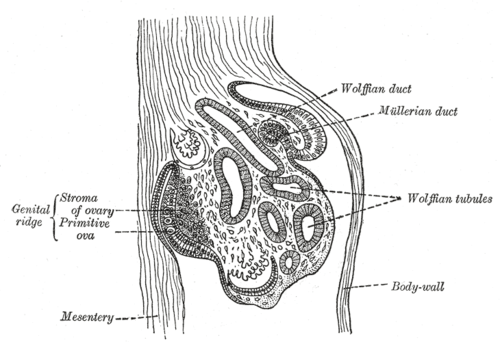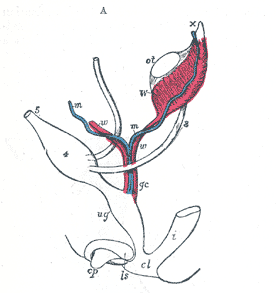Gonadal ridge
In embryology, the gonadal ridge (or urogenital ridge[1]) is the precursor to the gonads. The gonadal ridge initially consists mainly of mesenchyme and cells of underlying mesonephric origin. Once oogonia enter this area they attempt to associate with these somatic cells. Development proceeds and the oogonia become fully surrounded by a layer of cells (pre-granulosa cells).
| Gonadal ridge | |
|---|---|
 Section of the fold in the mesonephros of a chick embryo of the fourth day. ("Genital ridge" labeled at left.) | |
| Details | |
| Precursor | urogenital folds |
| Gives rise to | sex cords |
| System | Reproductive system |
| Identifiers | |
| Latin | crista gonadalis |
| TE | E5.7.1.0.0.0.5 |
| Anatomical terminology | |
The gonadal ridge appears at approximately five weeks, and gives rise to the sex cords.

* 3. Ureter.
* 4. Urinary bladder.
* 5. Urachus.
* cl. Cloaca.
* cp. Elevation which becomes clitoris or penis.
* i. Lower part of the intestine.
* ls. Fold of integument from which the labia majora or scrotum are formed.
* m, m. Right and left Müllerian ducts uniting together and running with the Wolffian ducts in gc, the genital cord.
* ot. The gonadal ridge from which either the ovary or testis is formed (upper right).
* ug. Sinus urogenitalis.
* W. Left Wolffian body.
* w, w. Right and left Wolffian ducts.
Associated genes
Genes associated with the developing gonad can be categorized into those that form the sexually indifferent gonad, those that determine whether the indifferent gonad will differentiate as male or female, and those that promote differentiation into male or female parts. Genes that form the sexually indifferent gonad are SF1 and WT1. Genes that determine sex are SRY, SOX9, and DAX1. Genes driving the differentiation into male or female structures are SF1, WT1, and WNT4. SRY is the only gene expressed solely in the developing gonad. The other genes have roles in development that aren’t exclusively sex-related. (Raymond 1999)
DMRT1
Evidence suggests that a DM domain gene, DMRT1, is involved in sexual development. This gene is located on chromosome 9. Its location suggests that it’s required for the development of testis. XY humans hemizygous for the chromosome 9p, where DMRT1 is located, are often feminized. This feminization can range from ambiguous genitalia to XY sex reversal. The DMRT1 homolog from chicken has been localized on the Z chromosome. Birds have heterogametic females (ZW) and homogametic males (ZZ). The avian Z chromosome is conserved synteny with chromosome 9 of humans. ZZ embryos have a higher dose of DMRT1 and therefore have the potential to have a higher expression. It’s been suggested that embryos with a higher expression of Dmrt1 expression develop into males while embryos with a lower expression are led to female development. (Raymond 1999)
In the mouse gonadal primordium, the genital ridge, which forms from intermediate mesoderm, becomes morphologically distinct at E10.5. By E12, sexual differentiation of the gonad is apparent, indicating that genes involved in the formation of the bipotential gonad is expressed before E10.5 and E12. Before E10.5, Dmrt1 is expressed at similar levels in the genital ridges of XX as well as XY embryos. By E12.5 and E13.5, DMRT1 is expressed deferentially as sex specific structures start to form. By E14.5 and E15.5, DMRT1 expression is maintained in the testis while it has begun to decrease in the ovary. (Raymond 1999)
SRY
In mice, the genital ridge houses the transcript for SRY, the Y-chromosomal gene responsible for sex determination in mammals. The urogenital ridge is made up of the gonadal anlage and the mesonephros. The mesonephros is involved in the development of the testis, but its role is in differentiation, and not determination. This is indicated by the absence of SRY expression in the mesonephros. SRY expression is expressed exclusively in the developing gonad, lacking a presence in any other tissue in embryos or adults. The presence of SRY in the genital ridge results in testis formation by directing the differentiation of Sertoli cells in a bipotential genital ridge. (Jeske 1995)
See also
References
- 2. Jesle, Y. et al. "Expression of a linear Sry transcript in the mouse genital ridge." Nature Genetics 10: 480-482 (1995)
- 3. Raymond, C. et al. "Expression of Dmrt1 in the Genital Ridge of Mouse and Chicken Embryo Suggests a Role in Vertebrate Sexual Development." Developmental Biology 215:208-220 (1999)
External links
- Swiss embryology (from UL, UB, and UF) cgametogen/keimbahn02